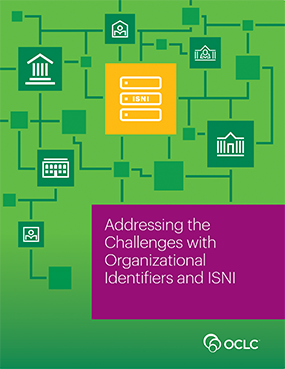Addressing the Challenges with Organizational Identifiers and ISNI
by Karen Smith-Yoshimura, Janifer Gatenby, Grace Agnew, Christopher Brown, Kate Byrne, Matt Carruthers, Peter Fletcher, Stephen Hearn, Xiaoli Li, Marina Muilwijk, Chew Chiat Naun, John Riemer, Roderick Sadler, Jing Wang, Glen Wiley, and Kayla Willey
#orgidreport #oclcresearch
Highlights:
- Organizational identifiers provide the means for a variety of stakeholders to find and identify an organization accurately and define relationships among its sub-units and with other organizations.
- The modeling of organizations provided can be adapted by others for their own uses, including linked data implementations.
- Identifying and tracking organizations presents multiple challenges.
- The International Standard Name Identifier (ISNI) has the means to disambiguate organizations and to meet the needs identified by 12 use-case scenarios.
- The ISNI database already includes over 500,000 institutional identifiers derived from the registries of agencies with business needs for identifying institutions.
- An outreach document targeted to academic administrators presents the reasons why organizational identifiers are important and the benefits of ISNI membership.
- Organizations need to take responsibility for maintaining current and accurate information associated with their identifiers.
Abstract:
Organizational affiliations of the creators of works are important to a variety of stakeholders, including academic administrators, funders, publishers, repository managers, software developers, rights agencies, and individual researchers. Identifying and tracking these affiliations can be challenging, as organizations may be known by a variety of names and may have schools or research centers well-known on their own. An organizational identifier— a unique, persistent and public URI associated with the organization that is resolvable globally over networks via specific protocols—provides the means to both find and identify an organization accurately and to define the relationships among its sub-units and with other organizations. This report presents new modeling of organizations that others can adapt for their own uses.
This report focusses on organizational identifiers from the perspective of academic institutions. Their ranks and reputation often determine their success in obtaining funding and attracting or retaining faculty. Identifiers provide the “glue” for institutions and funder systems to support comparing and ranking the outputs of the research process; assessing the impact of grants between institutions and their funders; and tracking and collating publications between researchers and their publishers. The report outlines a number of scenarios where the International Standard Name Identifier (ISNI) can be used to disambiguate organizations, including real-world examples.
Suggested citation:
Smith-Yoshimura, Karen, Janifer Gatenby, Grace Agnew, Christopher Brown, Kate Byrne, Matt Carruthers, Peter Fletcher, Stephen Hearn, Xiaoli Li, Marina Muilwijk, Chew Chiat Naun, John Riemer, Roderick Sadler, Jing Wang, Glen Wiley, and Kayla Willey. 2016. Addressing the Challenges with Organizational Identifiers and ISNI. Dublin, Ohio: OCLC Research. http://www.oclc.org/content/dam/research/publications/2016/oclcresearch-organizational-identifiers-and-isni-2016.pdf.
Short URL: isni-report
Resources
- Learn more about our research collections and support work.
- Read our related report: Registering Researchers in Authority Files
- Attend the webinar.
For more information:
Karen Smith-Yoshimura
Senior Program Officer
OCLC Research
